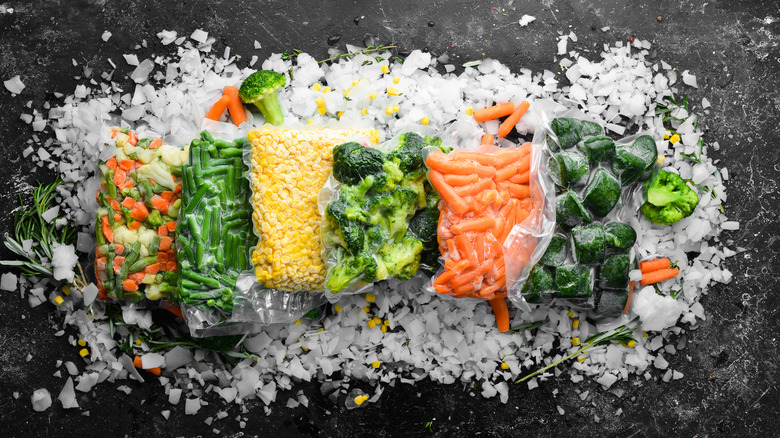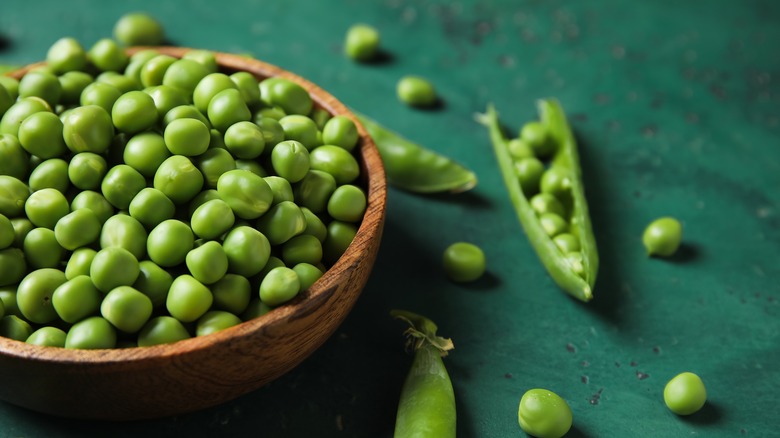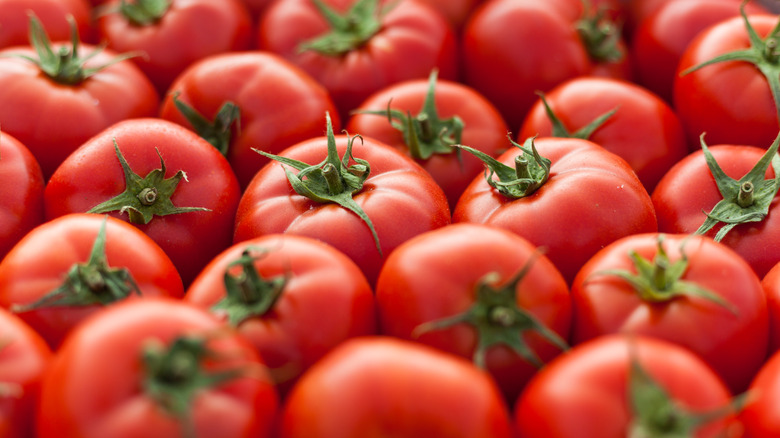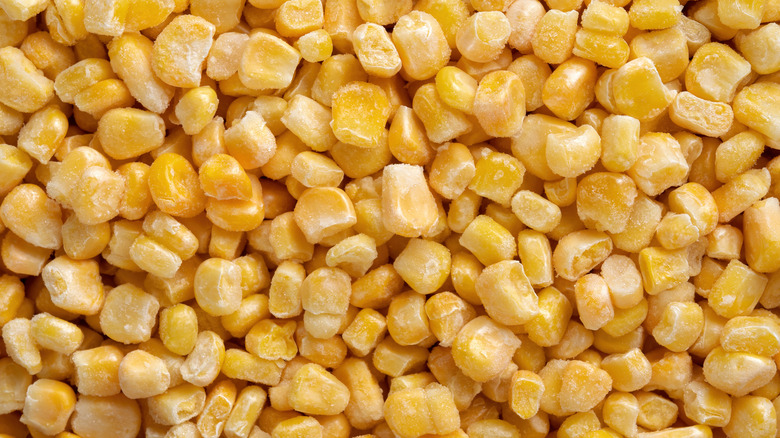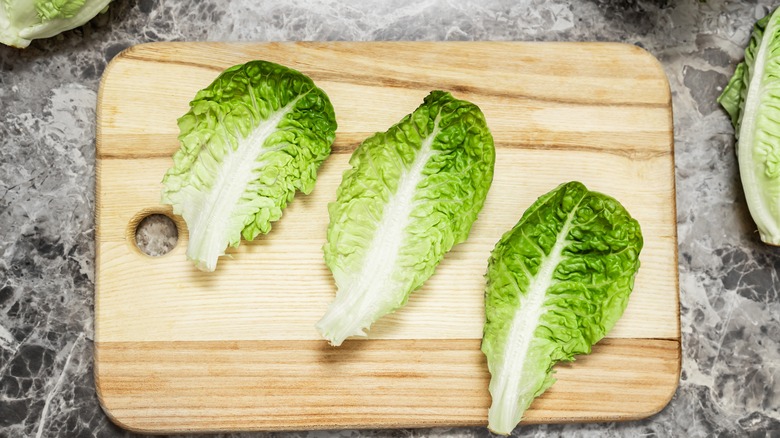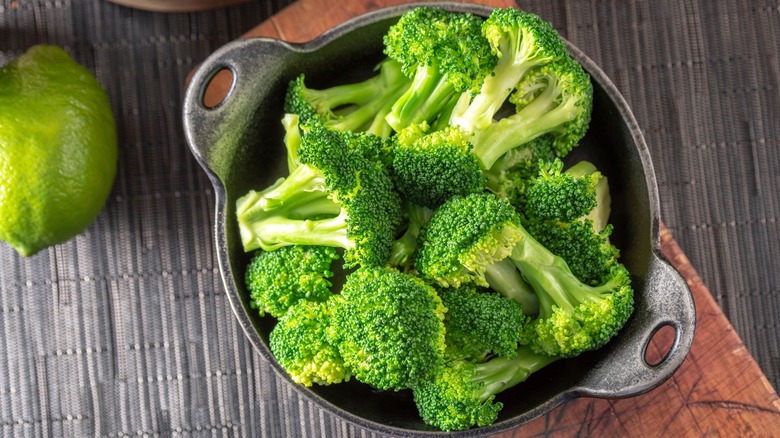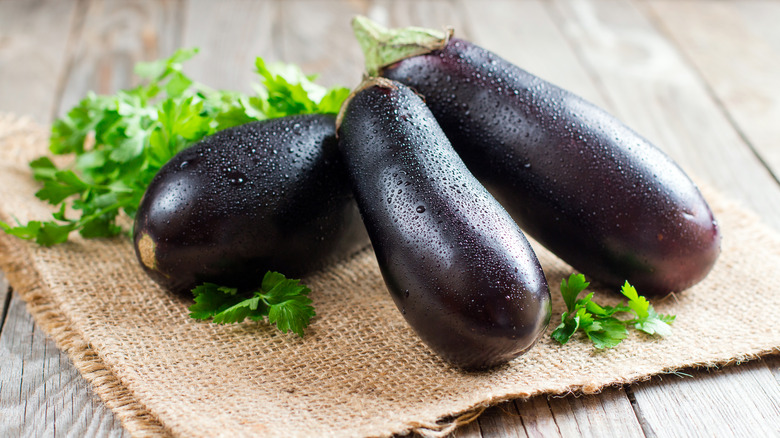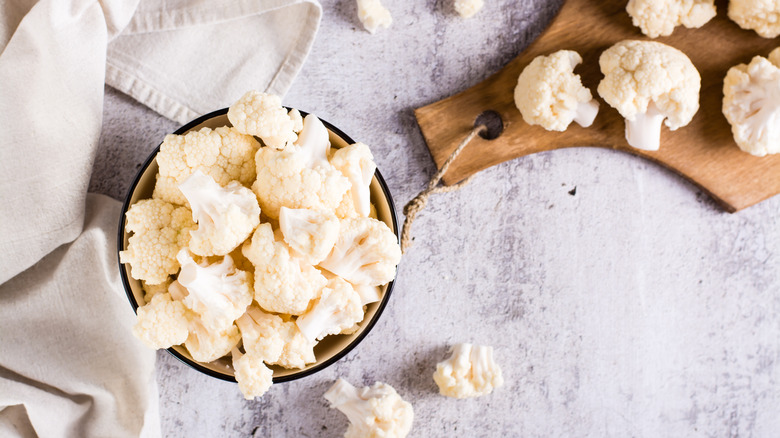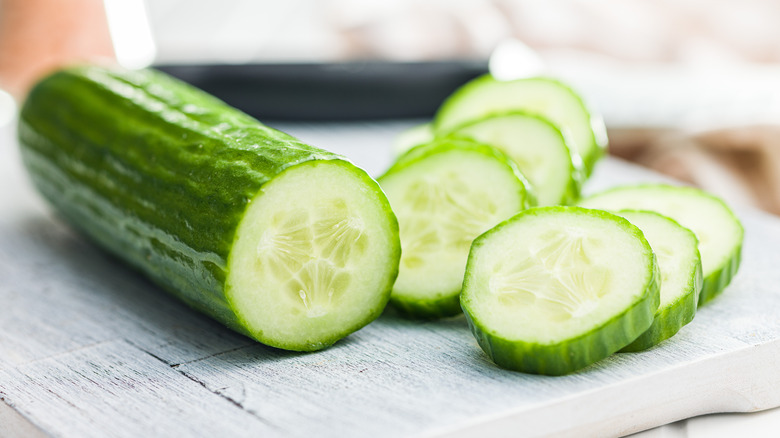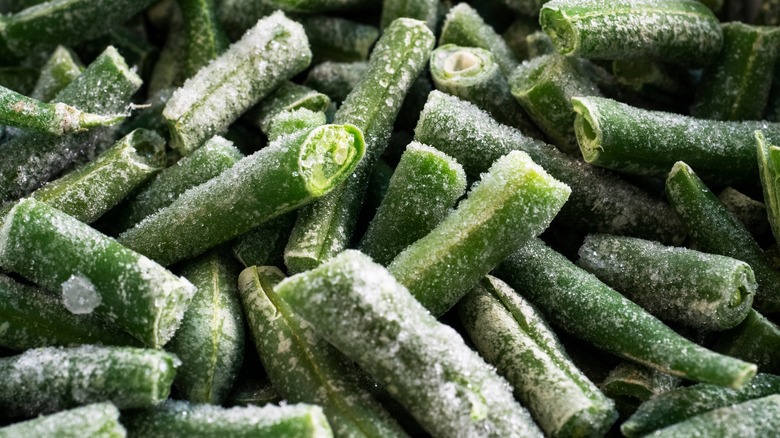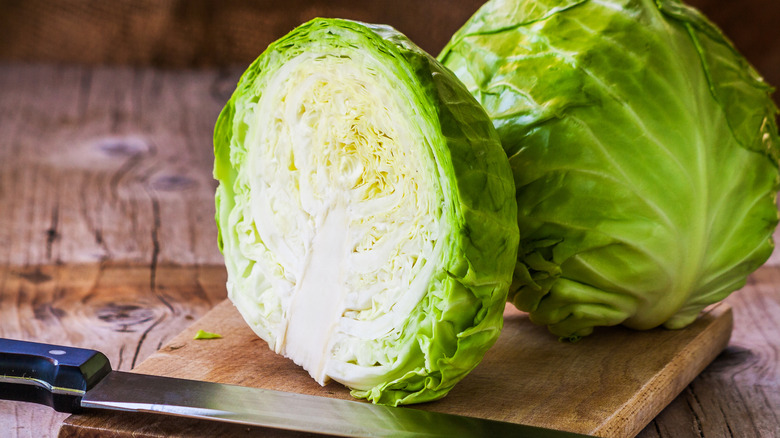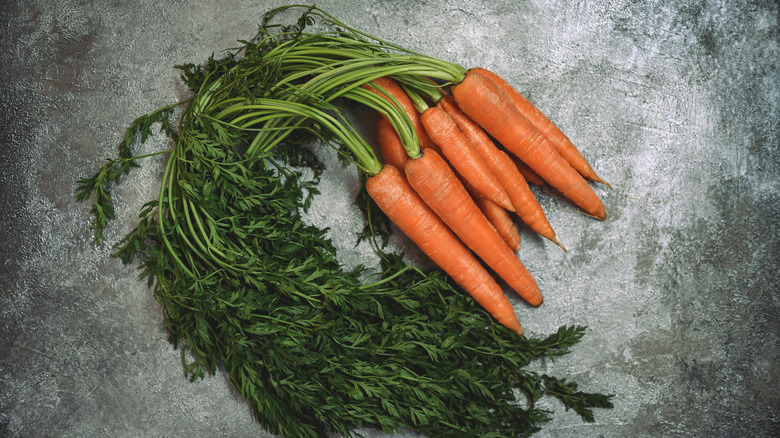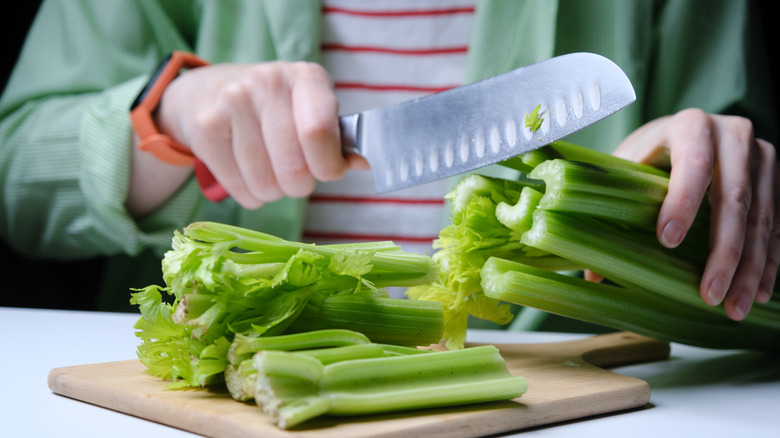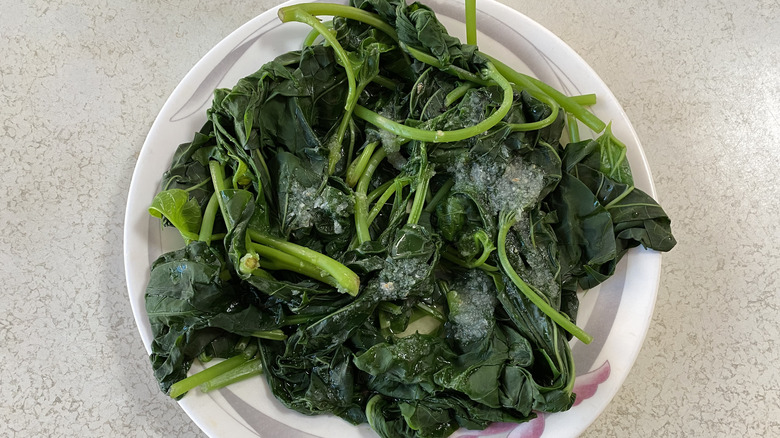7 Highest Quality And 6 Lowest Quality Frozen Vegetables
While little else rivals the crispness and flavor of fresh vegetables, frozen vegetables don't fall all that far behind. Freezing vegetables at a low enough temperature — often through fast-paced flash freezing – gives them surprising longevity, preserving their nutritional value and upholding their initial quality. Plus, freezing veggies dramatically extends their shelf life, which often equates to less food waste.
Yet the quality of frozen vegetables can vary. Some maintain their texture and flavor better than others, primarily due to differences in water content and cell structure. More than 90% of the weight of most vegetables comes from water, after all. This is part of why they freeze so well: the water in their cells is what's being frozen.
However, veggies with the highest water content tend to lose their structural integrity when frozen, as ice crystals can damage cell walls when they form. When those veggies are thawed, they don't maintain their original structure and can easily become mushy. Another factor is the sturdiness of their cell structure, which determines how well they withstand the freezing and thawing process. With all that in mind, let's dive into which veggies hold up the best in the freezer and which ones don't fare quite as well.
Highest quality: green peas
When it comes to frozen vegetables, green peas are often considered the gold standard. Their high starch content and dense cell structure set them apart from many other produce, allowing them to maintain excellent texture and flavor through the freezing process. Peas also have significantly lower water content than most other vegetables. This means they are less likely to suffer from cell wall rupture when the water inside them freezes and expands, preventing them from becoming mushy upon thawing.
Blanching, a process where produce is briefly boiled and then rapidly cooled in ice water, is crucial for preserving the quality of frozen peas. This step inactivates enzymes that can cause spoilage and degrade the peas, ensuring they remain crunchy and flavorful. Additionally, blanching helps to preserve their vibrant green color and nutritional value, locking in vitamins and minerals.
When you thaw and cook frozen peas, you'll often find that they taste almost indistinguishable from fresh peas. Their texture remains firm and their sweet, earthy flavor is intact. Overall, green peas showcase impressive resilience when frozen, which makes them a dependable veggie that you'll always be able to have on hand.
Lowest quality: tomatoes
Without a doubt, tomatoes are watery produce (botanically speaking, they're fruits, but given how they're often used alongside veggies, we think it's fair to include them here). It doesn't take much more than cutting one open to see that. Juicy and delicious as they are fresh, their high water content and their softer texture do not make them an ideal candidate for freezing raw. A large portion of the inside of the tomato is watery, which will turn into ice crystals when frozen. The result is that, when you thaw those tomatoes, the crystals will melt and turn the whole vegetable into mush. If you're using them for a sauce where they'll cook down anyway, this is probably fine, but you will certainly notice the difference in texture if you're eating them in a salad. Even a tomato with a moderately firm body, such as a cherry tomato, doesn't usually remain firm after it's been frozen and defrosted.
There are ways to freeze tomatoes to make them less mushy, such as slicing them before freezing. Despite these efforts, the texture of frozen tomatoes typically falls short of the firmness and freshness of their raw counterparts. For the best tomato experience, opting for fresh ones is typically recommended so you can fully savor their texture and flavor profile.
Highest quality: corn
Corn's low water content and dense, high-starch characteristics make it well-suited for freezing. Specifically, corn has a remarkably low water content of only 76% on average. This minimizes the risk of cell damage from freezing, allowing corn kernels to retain their firmness and natural sweetness when they are finally thawed. The dense, high-starch nature of corn further contributes to this resilience in the freezing process.
Before freezing corn, blanching it as you do with other vegetables will help to preserve its quality. This step not only retains the vibrant yellow color of the kernels but also locks in essential vitamins and minerals. As a result, properly blanched and frozen corn not only looks and tastes fresh but also maintains much of its nutritional value. Whether you incorporate it into hearty winter stews or enjoy it as a side dish in the summer, frozen corn provides a reliable and flavorful addition to meals year-round. Its ability to withstand freezing while preserving its original flavor, color, and texture makes corn a staple ingredient in many kitchens, offering convenience without sacrificing taste or nutrition.
Lowest quality: lettuce
One of the best things about lettuce of any sort is its refreshing taste and crunchy texture. These characteristics make lettuce an outstanding base for salads and an often welcome addition to sandwiches. However, these very same attributes present some serious challenges when it comes to preserving its quality through freezing.
The delicate structure and high water content of lettuce are what make it particularly ill-suited for freezing. When lettuce freezes, the water inside its cells forms ice crystals that rupture the cell walls. When thawed, the lettuce will have a soggy texture that is very noticeable in raw dishes. Because lettuce is mostly consumed raw, it's hard to freeze without making it unappetizing. The same is true for almost any lettuce variety, though much less so for darker leafy greens with more firm structures. Still, even with methods like blanching deployed to minimize damage, frozen lettuce tends to lose its appeal and may even taste slightly off compared to its fresh counterpart.
Highest quality: broccoli
Broccoli is a standout vegetable when it comes to maintaining high quality through the freezing process. This is in part due to its slightly lower water content compared to many other vegetables. Broccoli preserves its flavor, texture, and nutrients exceptionally well, particularly when blanched before freezing. Blanching broccoli not only halts enzyme activity that can cause spoilage but also enhances the nutritional profile by increasing its vitamin B2 content (via Journal of Agricultural and Food Chemistry).
Consumers frequently report that frozen broccoli maintains its integrity, staying just as firm and flavorful as fresh broccoli, at least as long as it is not overcooked. This makes frozen broccoli an excellent choice for a variety of recipes, from quiches and casseroles to steamed side dishes. In addition to its impressive texture and taste, frozen broccoli offers convenience and reduces food waste by extending its short five-day average shelf life to much longer. Whether you're preparing a quick weeknight dinner or stocking up for future meals, frozen broccoli is a reliable and healthful option that doesn't compromise on quality.
Lowest quality: eggplant
Eggplant is not particularly suitable for freezing, which can be attributed to a couple of key factors: its soft exterior structure and high water content. Eggplant is 93% water, so it is prone to forming large and pervasive ice crystals when exposed to freezing temperatures. These ice crystals expand and puncture the cell walls, causing irreversible damage to the eggplant. The result is that thawed eggplant turns to an unpleasant pile of mush and loses a lot of flavor, making it a much less appetizing.
In culinary terms, while eggplant is a versatile and flavorful ingredient when it's prepared fresh, its sensitivity to freezing limits its application ... unless it's been properly prepared beforehand. For example, you can try slicing and cooking the eggplant before freezing it, as this will lead to some dehydration and cut back on the ice crystal formation. Techniques like cooking or blanching before freezing can also help mitigate the challenges of freezing eggplant by reducing water content and enzyme activity, preserving more of its texture and nutritional value for later use. However, even these techniques are unlikely to completely keep you from experiencing a mushy defrosted eggplant.
Highest quality: cauliflower
Cauliflower excels as a frozen vegetable thanks to its excellent structure and water composition. It has a dense body with relatively low water content, allowing it to withstand the freezing process without issue. These attributes minimize the formation of ice crystals that can damage cell structures, ensuring that cauliflower typically maintains its texture and flavor quite well after thawing. Cutting up cauliflower and blanching it before freezing will make this all the better, as this process deactivates enzymes that can diminish flavor, texture, and color. By stopping these enzymatic activities, blanching ensures that the cauliflower remains as close to its fresh state as possible, even after freezing.
Frozen cauliflower integrates seamlessly into numerous recipes without a significant loss of firmness, crunch, or flavor. This means you may even be able to use previously frozen cauliflower raw. Additionally, properly frozen cauliflower retains its nutritional value, providing essential vitamins, minerals, and other nutrients like vitamin C and fiber. Overall, cauliflower's resilience to freezing while maintaining its key qualities makes it a top choice for those looking to stock up on this nutritious and versatile vegetable.
Lowest quality: cucumbers
Among the produce with the highest water content is the refreshing and delicious cucumber (another fruit that's often used as or alongside vegetables from a culinary standpoint). Yet it is typically made up of a whopping 96% water, so while it makes sense that eating a cucumber can be quite thirst-quenching, it's a terrible candidate for freezing. When you freeze one, the vast amount of water inside is what's actually freezing, leading to the formation of large ice crystals. During the thawing process, all that water is released and the cells of the vegetable body collapse. What you end up with is a soggy and limp cucumber, with nothing like the crunch and flavor you get when it's fresh.
Slicing cucumbers before freezing can help release some of the water and mitigate the damage to cell structure to some extent. However, even with this precaution, frozen cucumbers generally do not retain their original texture or taste. Unlike heartier vegetables that can withstand freezing without significant loss of quality, cucumbers are best enjoyed fresh to fully appreciate their crunchy texture and mild, refreshing flavor.
Highest quality: green beans
Green beans are another great vegetable to freeze, thanks to their relatively low water content, which reduces the risk of ice crystal formation that can damage the cell structure and lead to mushiness. This way, green beans typically maintain their firm, crisp texture even after defrosting. Another advantage green beans have is their sturdy structures, which help the veggies to retain their shape and snap so they continue to taste fresh and vibrant even after freezing.
While blanching — to be clear, that's the simple steps of briefly boiling and then cooling the green beans in ice water — is often recommended to preserve color and deactivate enzymes, many find that green beans retain their excellent texture and flavor even without this extra step. Nutritionally, green beans are also a powerhouse, and freezing doesn't diminish that value. They remain rich in vitamins A, C, and K, as well as fiber, making them a healthy addition to any diet. This makes them versatile for a range of dishes, from quick sides to hearty main courses.
Lowest quality: cabbage
Relative to other vegetables, cabbage's water content is on the low end. Despite this advantage, cabbage leaves have a delicate cellular structure that is more prone to damage during the freezing and thawing process. The formation of ice crystals within the leaves can easily rupture those cell walls, causing the cabbage to become limp and soggy when thawed.
Cabbage is hard to blanch uniformly because its leaves vary significantly in thickness and density. So, while blanching cabbage before freezing can help inactivate its enzymes and lead to flavor, color, and texture deterioration, if it's not blanched properly, the texture and flavor will still be compromised. What's more, blanching cabbage breaks down its chlorophyll, making it degrade more quickly even while it's tucked away in your freezer. Blanching cabbage can also reduce its vitamin C content, affecting its flavor and nutritional quality compared to fresh cabbage. If you're considering freezing cabbage anyway, opting for cooked dishes over raw ones is preferable. Thawed cabbage tends to lose its crunchiness, which may not be as noticeable in a stir fry compared to a raw dish like coleslaw.
Highest quality: carrots
If you bite into a raw carrot, it will become immediately clear that it's a dense and sturdy vegetable. These elements, together with the relatively low water content of this root vegetables, makes it perfect for freezing without compromising quality when it comes to structure or flavor. Specifically, carrots are composed primarily of cellulose and hemicellulose, which are complex carbohydrates forming their cell walls. These components contribute to their robustness, preventing the formation of ice crystals that can damage cellular structures and lead to textural degradation. As a result, frozen carrots retain their firmness and crunch, so you'll get a pleasant mouthfeel even after being frozen and thawed.
Like most vegetables, the standard process before freezing carrots is to blanch them. This improves their freeze-thaw stability. The brief exposure to boiling water inactivates enzymes that could otherwise degrade the vegetable's color, flavor, and nutritional content over time. On top of that, blanching helps to reduce the carrots' moisture content, which further aids in preserving their texture and preventing sogginess upon thawing.
Lowest quality: celery
Celery is really not the best veggie to freeze, mainly because it's over 95% water. All that water content makes it prone to forming big ice crystals when it's frozen, which end up leaving it on the softer side when you thaw it out. Plus, freezing celery diminishes its earthy taste, so it doesn't quite hit the spot like fresh celery does.
Even if you try blanching it before freezing to preserve some of its snap and flavor, you'll still notice a dip in quality. Blanch or no blanch, thawed celery will end up in a limp and crunchless state. Still, sometimes it makes sense to freeze celery. For instance, if you buy a whole bag but can't use it up before it goes bad, your best bet is to use the frozen celery in cooked dishes instead of raw. That way, you can still enjoy its nutritional perks, like its rich levels of dietary fiber and vitamin K, and fit it into your recipes without being disappointed by its lost texture. If you've got to use it, consider using frozen celery in recipes like gumbo, vegetable soup, or stuffing.
Highest quality: spinach
Spinach may not seem like a likely candidate for freezing because of its delicate nature and high water content. Typically, vegetables with high levels of water can become mushy and lose color when they are frozen. This is especially true of many other lettuce greens, which do not hold up well when frozen. However, spinach defies these expectations because it has more dense cells than other leafy greens. The same is true for other darker greens, such as kale. However, for it to retain its rich green color and nutrient levels, it must be blanched first. This process also reduces spinach's water content slightly, contributing to its ability to maintain a more pleasant texture when it's thawed and cooked, though it will likely lose most of its texture compared to raw, fresh spinach leaves. Some research has even found that frozen spinach is higher in certain nutrients, such as vitamin C, than fresh spinach (via Food Chemistry).
It's common to use spinach in a variety of cooked dishes, whereas lettuce is primarily used raw. This is another reason it's a great vegetable to freeze, as its changed texture post-thawing won't be as much of an issue in cooked applications. Frozen spinach holds up well for easy use in a whole slew of recipes, from creamy dips to tasty quiches to hearty pasta sauces.
